1980s

After decades of remarkable achievements, the early 1980s marked a time of transition and celebration for the AIUM. During this period, the institute celebrated its 25th anniversary, revamped its membership categories, and reorganized several components of its business structure.
Not only was the AIUM celebrating 25 years as a flourishing organization, but it also was positioning itself for continued success. As such, during this time, the AIUM announced plans to relocate its executive office from Oklahoma City, Oklahoma, to Bethesda, Maryland, a suburb of Washington, DC. During his term as president, Richard Meyer, MD played a crucial part in the planning and designing of the new office. By relocating to the DC area, the AIUM hoped to increase its visibility and amplify the professional recognition of its members.
In the early 1980s, the AIUM also created a new journal, the Journal of Ultrasound in Medicine (JUM). During Marvin Ziskin, MD's first year as president in 1982, the JUM became the official AIUM journal. It would replace the Journal of Clinical Ultrasound (JCU), and, unlike the JCU, which was owned and published by John Wiley and Sons, Inc, the JUM would be owned by the AIUM and published by the W. B. Saunders Company, starting January 1, 1982. George Leopold, MD, was chosen as the editor of the JUM, and subsequently resigned as editor of the JCU.
Our most important accomplishment, however, has been the establishment of an independent, copyrighted journal, the Journal of Ultrasound in Medicine.In 1982, the Pioneer Award was renamed to honor Joseph H. Holmes, MD, who died that year. Dr Holmes, the first person named as an AIUM pioneer, was an important figure to both the field of diagnostic ultrasound and the AIUM.
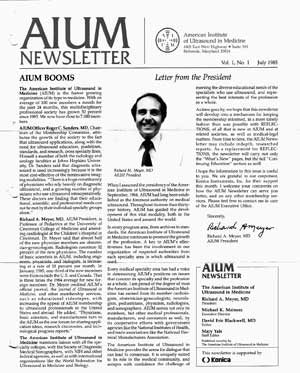
Volume 1, Number 1 of the AIUM Newsletter was published in July 1985. The newsletter served as a means of keeping the AIUM membership informed of the organization's activities. In 1986, the AIUM's publishing activities and educational offerings continued to expand to meet the needs of the growing membership.
In July 1987, the first AIUM Bioeffects Conference was held in Stowe, Vermont. The invaluable conclusions from that conference focused on 2 mechanisms of primary concern relative to the safety of ultrasound: cavitation and heat.
In mid-1988, the AIUM published a new patient brochure, What You Should Know About Your OB Ultrasound Exam. The 8-panel pamphlet answered the questions most asked by patients. It was the first of a series of patient brochures planned by the AIUM, each covering a different ultrasound examination.
A special highlight of the 1988 WFUMB/AIUM Meeting was the History of Ultrasound Symposium and Exhibition, which featured equipment used by pioneers John J. Wild, MD, PhD, and Douglass Howry, MD. To coincide with the history symposium, the AIUM, in conjunction with WFUMB and Eastman Kodak Company, published Medical Diagnostic Ultrasound: A Retrospective on Its 40th Anniversary, an ultrasound history monograph.
Those of us involved in clinical ultrasound must be aware of the responsibility we owe our patients in practicing with proper concern for the safety and efficacy of the methods we employ.
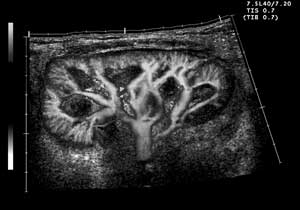
Power Doppler Imaging
Power Doppler is a color Doppler imaging mode in which the color displayed is based on an estimate of the total integrated Doppler power over a period of time at a given position. The value is related to the volume of blood present rather than its velocity.
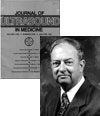
George Leopold, MD


Gray Scale 3D Imaging
A rendered display of an ultrasound image in which the subject matter is displayed in a third dimension.
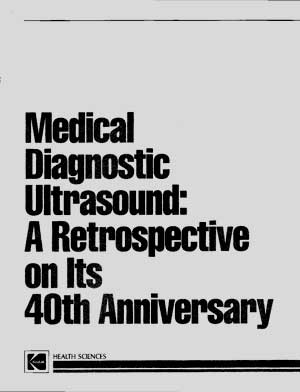
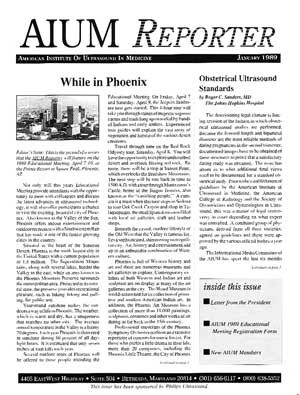
In 1989, the AIUM Newsletter was renamed the AIUM Reporter.
